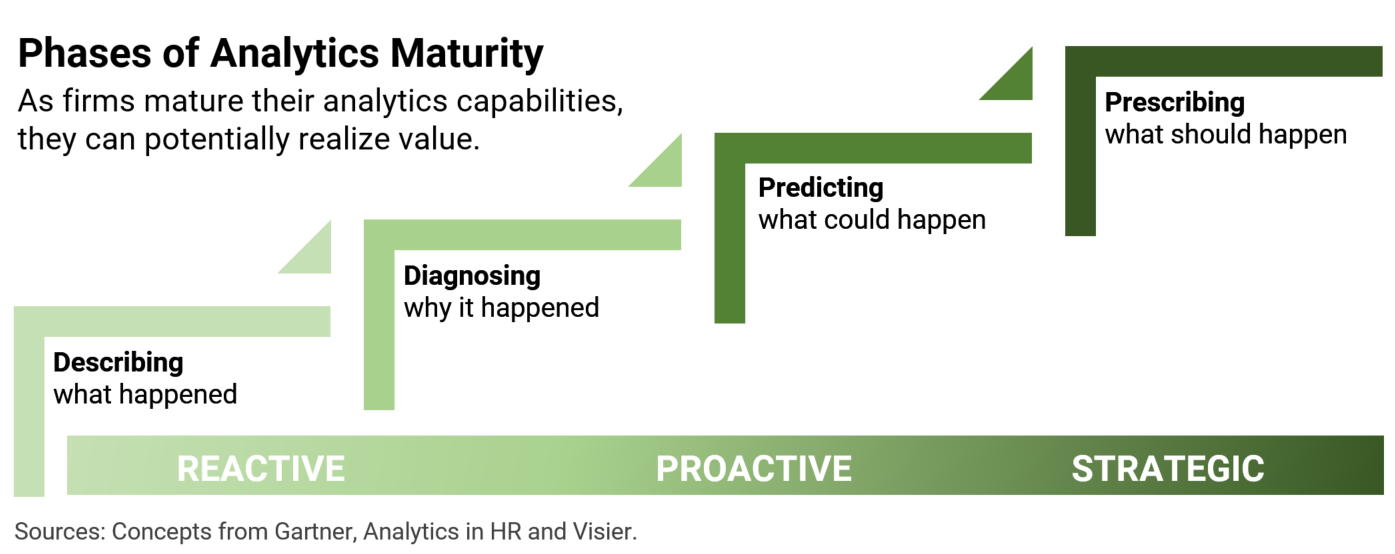Introduction to Workforce Analytics: Data-Driven HR
One of my friends recently got a job through Twitter, because apparently that’s a thing now. Indeed, we can browse countless job opportunities over breakfast. Meanwhile, the unemployment rate has reached near-historic lows the last few years.
The result of this connectivity and tight labor market? Job hopping, and lots of it.
If you’re an employer, this rapidly evolving labor market presents several challenges, such as:
- How do you keep your employees from hopping to wherever the grass is greener?
- How do you make your company stand out amidst the sea of online job postings?
- How do you most efficiently find the best candidate among a mountain of job applications?
Workforce analytics can help answer these questions.

Workforce analytics refers to the use of statistical methods to evaluate employee data, with the aim of gleaning insights to boost business performance. For example, if a firm is experiencing unusually high turnover, analytics can help determine who is leaving and why, plus inform the firm’s strategies for retaining talent.
What's the Definition of Workforce Analytics, Exactly?
If you’ve never heard of this field before, that’s OK.
While there are many definitions floating around, generally, workforce analytics is the use of statistical methods to evaluate employee data in order to gain insights on business performance. For a more detailed discussion, see Huselid, Mark A. "The science and practice of workforce analytics: Introduction to the HRM Special Issue” (PDF). Human Resource Management, 2018, Vol. 57, pp. 679-684. Sometimes this term is used interchangeably with people analytics or HR analytics.
The field is likely to grow in coming years.
In a survey of more than 11,000 business and HR leaders worldwide, Deloitte found that while only 42% of respondents felt their organizations were ready to use people data, 85% believed the trend towards using people data to be important. Deloitte, “2018 Deloitte Global Human Capital Trends” (PDF). March 2018.
Survey respondents in the tech, media and telecommunications or financial services industries were particularly likely to see people analytics as an important business trend, as were respondents from organizations with greater than 1,000 employees.
An Example of HR Analytics in Action: Reducing Employee Turnover
Consider this challenge: There were about 3.6 million instances of employees voluntarily leaving their jobs in July 2019. As the figure below shows, the rate of job quits is at a high not seen since 2001, according to the Bureau of Labor Statistics.
One reason why workers may be emboldened to quit their jobs is because in a tight labor market like we’re experiencing, people feel like they have a good chance of finding another position that may suit them better.
To illustrate workforce analytics in action, let’s consider how analyzing data might help an organization answer the question: How can we reduce quit levels and retain talented employees?
Imagine an employer has recently experienced an unusually high number of employee departures. Workforce analytics can help determine who is leaving. Perhaps it’s the employees newest to the workforce, who tend to job hop at higher rates than their more experienced peers. Decembrele, Blair. “The Job-Hopping Generation: Young Professionals Are On The Move.” LinkedIn Official Blog, Oct. 11, 2018.
Or maybe the data show that mid-career employees, who often feel stuck in their current roles, are leaving most.
Calculating and comparing turnover rates for specific groups of employees can pinpoint exactly where the departures stem from. Once a company knows who is leaving, analytics can help pave the way to the solution.
If Employees Newer to the Workforce Are Leaving …
Members of Gen Z tend to place particular emphasis on a strong relationship with their manager.Knowledge@Wharton. “Make Way for Generation Z in the Workplace,” January 22, 2019.
So, if employees fresh to the workforce are driving turnover in a firm, the company may want to look into training to help managers better adapt to the specific needs of these employees. By comparing the total cost of finding and training a new employee to the cost of manager training, a company can estimate how worthwhile it would be to spend on such training to help reduce turnover.
If More Tenured Employees Are Leaving …
Or, if most of the turnover is coming from mid-career employees, a company may need to determine why these employees feel they’ve hit a plateau. In some instances, as people reach the middle of their careers, their professional growth levels off. This can lead to boredom—the so-called “mid-career crisis." Wilkie, Dana. “Are Your Workers Bored? Uninspired? They May Be Suffering a Midcareer Crisis.” SHRM, April 12, 2018.
Analysis of internal promotion rates may illuminate where employees are stagnating in the same job for years on end, thus helping the firm figure out an optimal time to reassign talent in need of a new challenge.
Of course, that’s just the start. As the company makes decisions based on analytics, more data will continue to flow in. The firm must then evaluate how effective new initiatives are, how costly they turn out to be, and decide how to best adapt, if need be.
As such, the analytics work never truly ends.
The Future of Workforce Analytics
My background is in economic research, including econometrics, where we use complex math and statistics to uncover key insights that explain how the economy works. I wasn’t familiar with the field of HR analytics until I started working in it last year.
The Federal Reserve System—a data-driven institution—is embracing workforce analytics.
The Board of Governors established a workforce analytics team several years ago, and many of the Reserve banks, including the St. Louis Fed, have done so as well. (You can explore the latest career opportunities at the Board and careers at the St. Louis Fed, including a range of analyst positions.)
While workforce analytics allows researchers to glean key insights, it’s important to consider that it’s an ever-changing field and that continual analytics are important.
The diagram below shows current thinking around analytics maturity, moving from a reactive to proactive posture.

Description: This diagram shows a company’s progression in analytics. Stair steps show how firms can mature from using analytics to describe what happened, to diagnosing why something happened, to predicting what could happen in the future, to finally prescribing what ought to happen.
The example we ran through earlier—How can a firm retain employees and mitigate job-hopping?—exhibits some of the limitations of workforce analytics at the low end of the maturity scale.
Given the unpredictability of people, workforce analytics tends to be more backward-looking than forward-looking. For example, it is easier to understand who is leaving, and why, than to forecast which employees will leave in the future.
That makes sense, given how individualized such decisions are.
Could it be the case that workforce analytics eventually matures into the predictive and prescriptive phases of analytics? That remains to be seen. If people can use data to help forecast the weather, the economy, and the stock market, it stands to reason that workforce trends could be predicted.
As with other disciplines involving data, it’s not clear what workforce analytics will look like even 10 years from now.
That’s part of why I find this so intriguing. It will be interesting to see how workforce analytics evolves going forward, and how employers including the St. Louis Fed and the rest of the Federal Reserve System will continue to use data in order to gain insights on workforce trends.
Additional Resources
- Learn about the St. Louis Fed’s top-performing culture
- Discover how the Federal Reserve System is structured
- Read more about current labor market conditions in the latest Beige Book
Notes & References
- For a more detailed discussion, see Huselid, Mark A. "The science and practice of workforce analytics: Introduction to the HRM Special Issue” (PDF). Human Resource Management, 2018, Vol. 57, pp. 679-684.
- Deloitte, “2018 Deloitte Global Human Capital Trends” (PDF). March 2018.
- Decembrele, Blair. “The Job-Hopping Generation: Young Professionals Are On The Move.” LinkedIn Official Blog, Oct. 11, 2018.
- Knowledge@Wharton. “Make Way for Generation Z in the Workplace,” January 22, 2019.
- Wilkie, Dana. “Are Your Workers Bored? Uninspired? They May Be Suffering a Midcareer Crisis.” SHRM, April 12, 2018.
This blog explains everyday economics and the Fed, while also spotlighting St. Louis Fed people and programs. Views expressed are not necessarily those of the St. Louis Fed or Federal Reserve System.
Email Us


